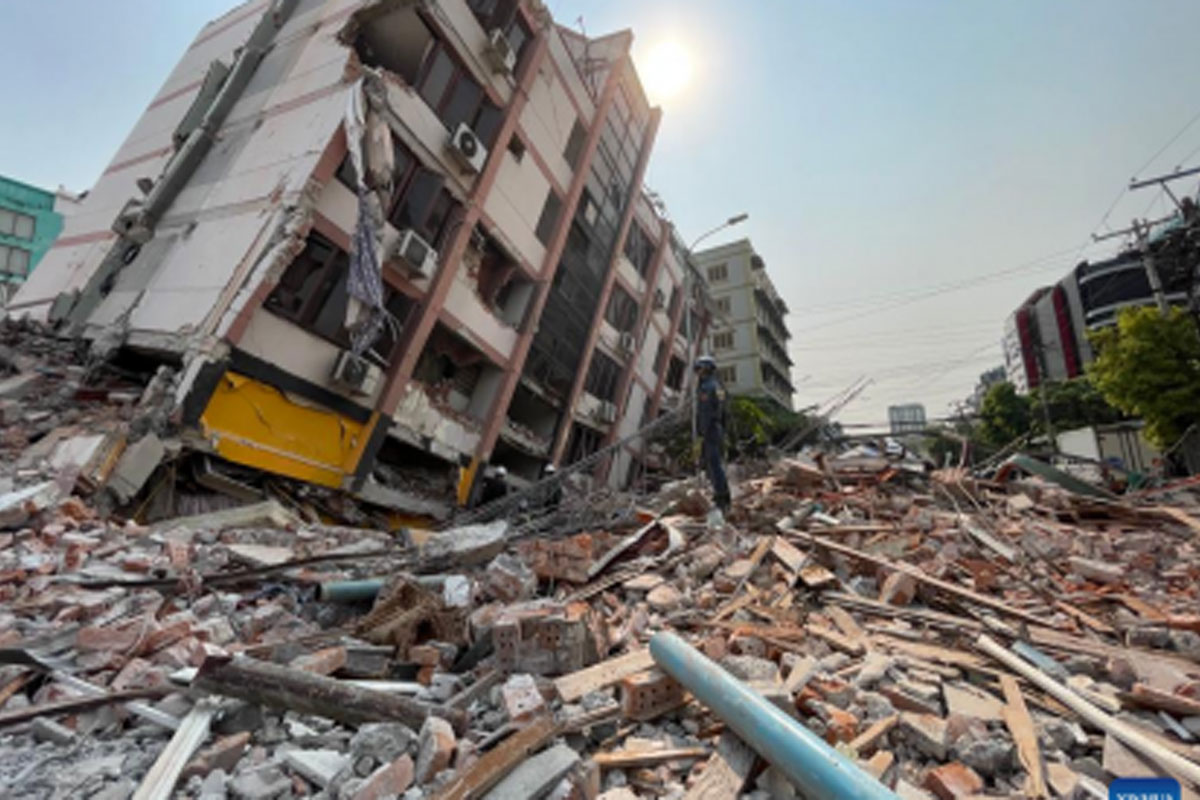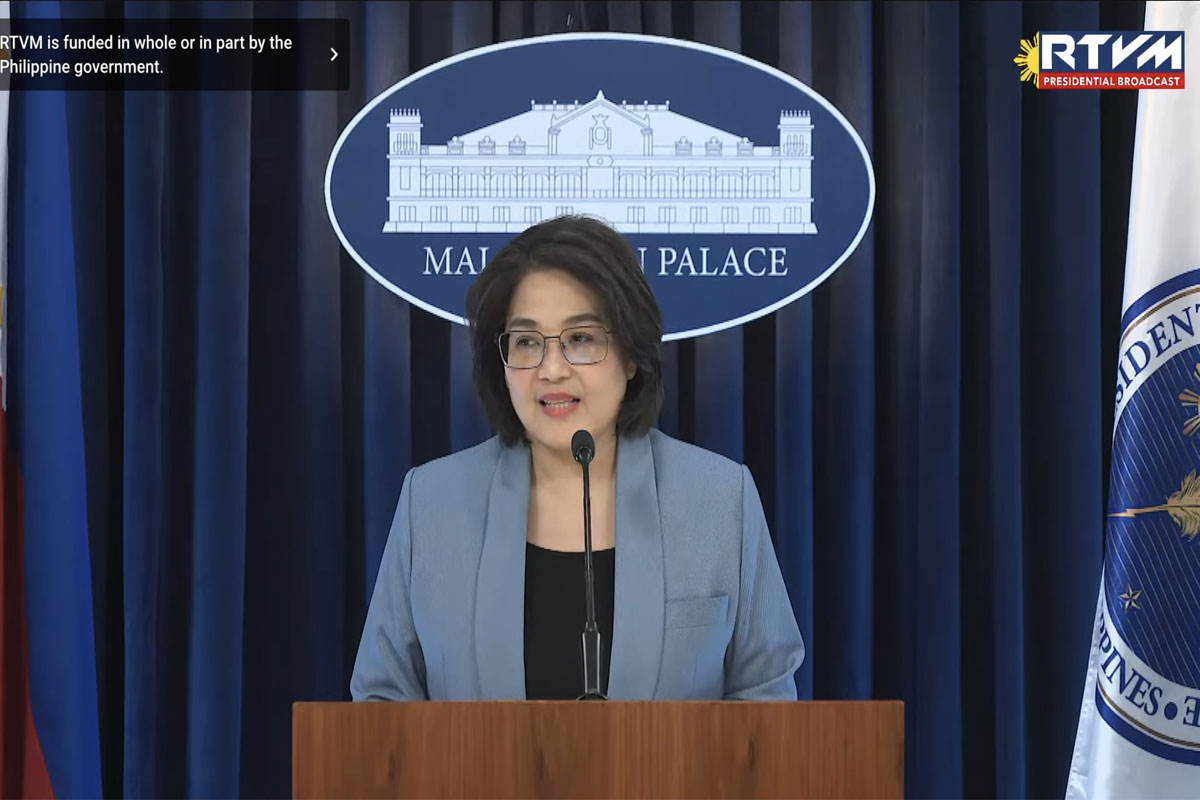 Source: PNA via Xinhua
Source: PNA via Xinhua
Villafuerte asks Senate to OK House-passed New Building Code
To better prepare PHL for “The Big One” like the Myanmar quake
WHILE expressing sympathy with earthquake-hit Myanmar and Thailand, Camarines Sur Rep. LRay Villafuerte has expressed the hope that the 7.7-magnitude tremblor that claimed the lives of over 2,000 people combined in our Southeast Asian neighbors would serve as an impetus for the Senate to pass its version of a long-approved climate-proofing measure of the House of Representative meant anytime to make Philippine infrastructure more resilient against natural disasters.
A former Camarines Sur governor, Villafuerte noted that the House of Representatives passed House Bill (HB) No. 8500, or the proposed “New Philippine Building Act,” back in 2023 to prepare our country for, among others, the so-called “The Big One” earthquake that experts fret could knock down at any time at least 10% of structures in Metro Manila and neighboring provinces.
“As we express our sympathy and support for tremor-devastated Myanmar and Thailand, I am hoping that last week’s magnitude 7 tremblor that sadly shook our two Southeast Asian neighbors would serve as a strong impetus for our senators to pass their counterpart to the House-approved climate-proofing overhaul of the Philippine Building Act,” said Villafuerte, a co-author of HB 8500.
The former governor said the House-approved HB 8500, or the “New Philippine Building Act,” which aims to amend our 47-year-old building code, actually preserves the power of local government units (LGUs) to issue their own statutes or regulations concerning buildings in their respective localities, for so long as these ordinances jibe with this proposed law.
Over the weekend, authorities reported that the 7.7-magnitude quake in Myanmar and Thailand thus far claimed the lives of some 2,000-plus people and injured more than 3,000 others, with the exact scale of the disaster still unclear at this point, especially in the mainly isolated Burmese state that is ruled by a military junta and is going through a civil war.
The Department of Foreign Affairs (DFA) said that four Filipino professionals were unaccounted for and among the missing individuals in Myanmar.
The shallow 7.7-magnitude tremor hit northwest of the city of Sagaing in Myanmar last Friday afternoon, followed minutes later by a 6.4-magnitude aftershock—destroying buildings and bridges, and with massive destruction reported in that country’s second biggest city of Mandalay.
After the earthquake, Naypyitaw declared a state of emergency in the six worst-affected regions and appealed for international aid.
The quake also hit neighboring Thailand, killing 12 people and injuring 26 individuals at three construction sites, including one where a high-rise building collapsed.
Following the Myanmar-Thailand tremors, Philippine Institute of Volcanology and Seismology (Phivolcs) director Dr. Teresito Bacolcol was reported as saying in a broadcast interview that a 7.2-magnitude tremblor, or the “Big One” quake that is expected to strike the Philippines, could kill as many as 50,000 people; injure another 100,000; and damage more than a tenth of residential building in Metro Manila and neighboring areas.
Bacolcol said that the Metro Manila Earthquake Impact Reduction Study jointly conducted in 2004 by the Japan International Cooperation Agency, the Metro Manila Development Authority (MMDA) and the Phivolcs that the movement of the West Valley Fault (WVF) would trigger a major earthquake.
He said the worst earthquake in the country occurred in August 1976 when at least 8,000 people died in the earthquake brought by the Cotabato Trench.
Based on historical records, a report said that the WVF or Marikina Valley Fault System on the eastern side of the national capital is due for “the Big One” within “our generation or the next generation.”
Citing a Department of Science and Technology (DOST) structural study of Metro Manila buildings, DOST Secretary Renato Solidum Jr., who is vice chairman of the National Disaster Risk Reduction and Management Council (NDRRMC), revealed that 10% to 13% are not disaster-resilient, as some of these infrastructure were built before the building code was amended in 1992.
During the Asia-Pacific Ministerial Conference on Disaster Risk Reduction (APMCDRR) held in Pasay City last year, Solidum said that, “What we are monitoring is the West Valley Fault. It is the worst-case scenario. Its last movement was 400 years ago … Around 25,000 to 30,000 people would be very critically injured, meaning the injury could lead to death.”
Retired Armed Forces vice admiral Alexander Pama, a former NDRRMC executive director and ex-administrator of the Office of Civil Defense (OCD), said at the same APMCDRR event in Pasay City that the death toll could be almost 47,000 people.
“Now, we have a population of about 14,677,000. If we extrapolate it very simply, we’re talking about a casualty figure of 46,993,” Pama said.
However, according to a report, a JICA study expects a potentially higher impact of a WVF earthquake that could lead to 50,000 casualties.
In July 1990, a major earthquake with a magnitude of 7.7 and epicenter near Rizal province hit Metro Manila, Central Luzon, Bicol and the Cordillera Administration Region (CAR) that killed more than 1,600; injured over 3,500; and displaced some 126,000 others.
Malacañan Palace has called on LGUs to ensure the safety of buildings in their respective localities, with Palace Press Officer and Communications Undersecretary Claire Castro telling local executives to order their respective building officers to conduct inspections and be strict in granting permits for the construction of buildings.
Although it was impossible to predict when disasters will occur, Castro said it was crucial for national government agencies and LGUs to be proactive in preparing for them and safeguarding lives.
Experts note that “The Big One” could be triggered by the anticipated movement of the 100-kilometer (km) Marikina Fault, which runs through eastern Metro Manila and surrounding provinces such as Bulacan, Rizal, Cavite, Laguna and Pampanga.
The last time that the WVF moved was in 1658.
The National Building Code of the Philippines was established in 1977 under Presidential Decree (PD) No. 1096 that was issued that year by then-President Ferdinand Marcos Sr. It was amended in 1992.
Villafuerte said that the approval of a climate-friendly building code, as proposed by HB 8500, will pave the way to the integration of strategies on disaster risk reduction with those on urban and infrastructure planning.
He explained that HB 8500 aims to create the Office of the NBO (ONBO), which is tasked to ensure that our buildings or structures are stronger or more tenacious in the face of earthquakes, storms, floods, fires, landslides and other natural hazards of increasing frequency and intensity.
For Villafuerte, “Climate change and the increasing frequency and intensity of natural disasters that hit the country make it necessary for us lawmakers to update our building and construction laws. Improvements in building regulations and standards are necessary to help us respond to our vulnerabilities to such disasters as earthquakes, typhoons and volcanic eruptions, given that the Philippines is situated along the Pacific ‘Ring of Fire.’”
The “Ring of Fire” is a region in the Pacific Ocean rim where most of the world’s volcanic eruptions and earthquakes occur.
The former governor said HB 8500 authorizes LGUs to pass their own building ordinances, so long as these are consistent with the proposed new building law.
Despite the creation of the Office of the NBO (ONBO), Villafuerte said that LGUs shall keep their autonomy on issuing regulations in their respective localities, as the consolidated HB 8500 retains the provision of HB 3686, which states that: “Nothing in this Act shall be interpreted to prevent LGUs, pursuant to local autonomy, from enacting local ordinances relating to buildings or structures and their location and planning that will better safeguard life, health, property, and public welfare, consistent with the objectives of this Act and the charter of the concerned LGU.”
HB 3686, which was one of the 10 bills consolidated into the House-passed HB 8500, was authored by Villafuerte with fellow CamSur Reps. Luis Miguel Villafuerte and Tsuyoshi Anthony Horibata and the Bicol Saro partylist.
He said the House-approved bill classifies, and prescribes construction standards and requirements for every category of buildings, including residential, business, commercial/mercantile, educational, agricultural, institutional, factory/industrial, storage, utilities, and high-hazard structures.
It also slaps penalties for violations, including fines, administrative sanctions and jail time of up to six years on violators, he said.
One requirement of the proposed new building code under HB 8500 is for all buildings and structures to be designed as to “minimize their negative environmental impact throughout their life cycle, through efficient energy, water and waste management methods, use of sustainable materials and landscaping that considers a site’s biodiversity and existing natural features, and climate change mitigating features, among other measures,” Villafuerte said.
Another HB 8500 requirement, he said, is on the strict use of building materials and components that are safe for the health of occupants; must not cause any substantive negative impact to the environment including air, water and soil; and follow “a set of criteria, including strength, fire resistivity, moisture resistance, durability, and sustainability, according to the rules and reference standards promulgated by the NBO.”
He noted that building construction plays a critical role in mitigating the impact of natural disasters.
For instance, New Zealand, which experiences about 100 to 150 earthquakes a year, is able to keep the average number of fatalities down to three per year, according to Villafuerte, by “enforcing mandatory retrofitting for buildings not up to par with current codes on top of a strict compliance policy for all new developments.”


















